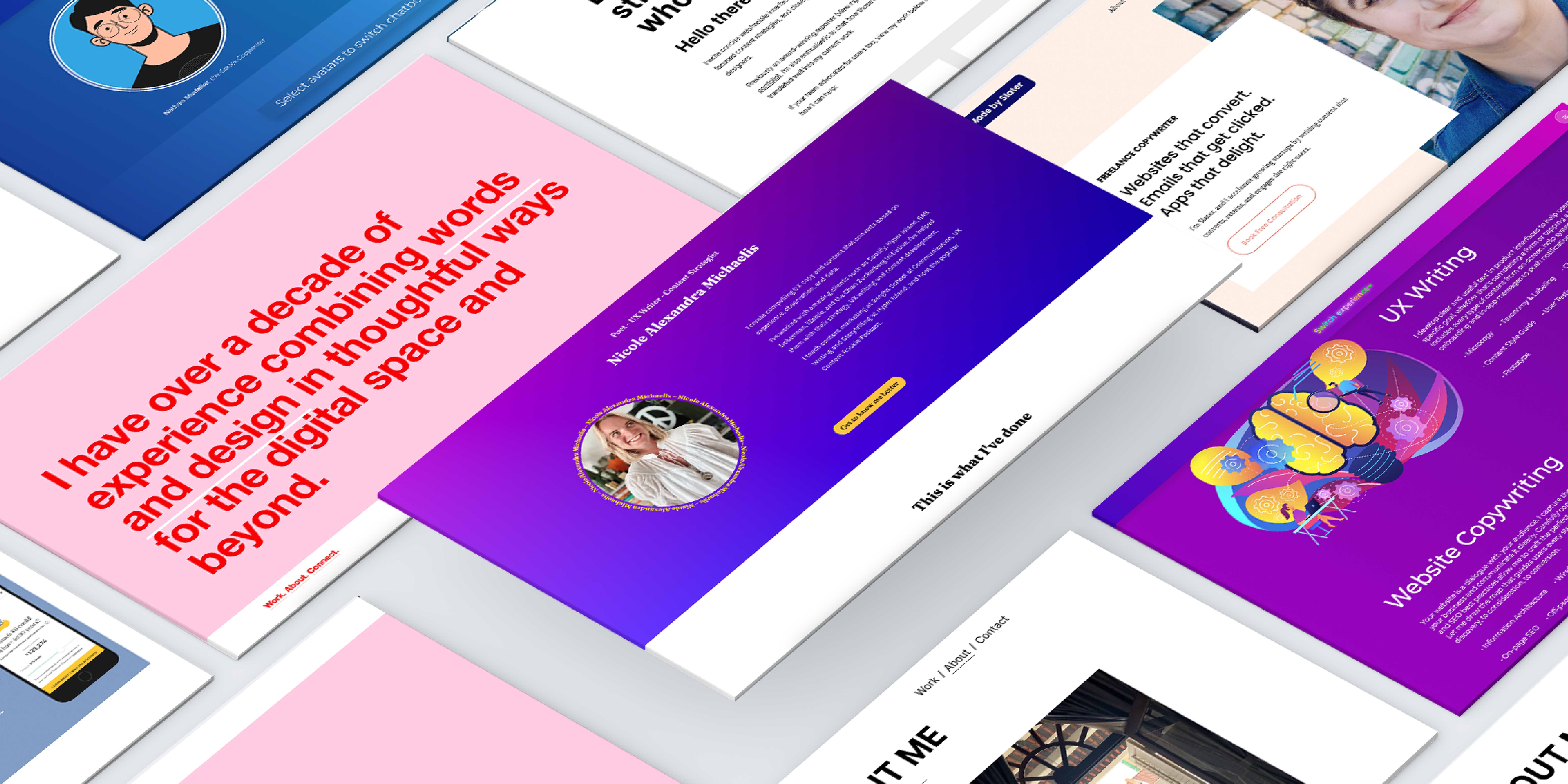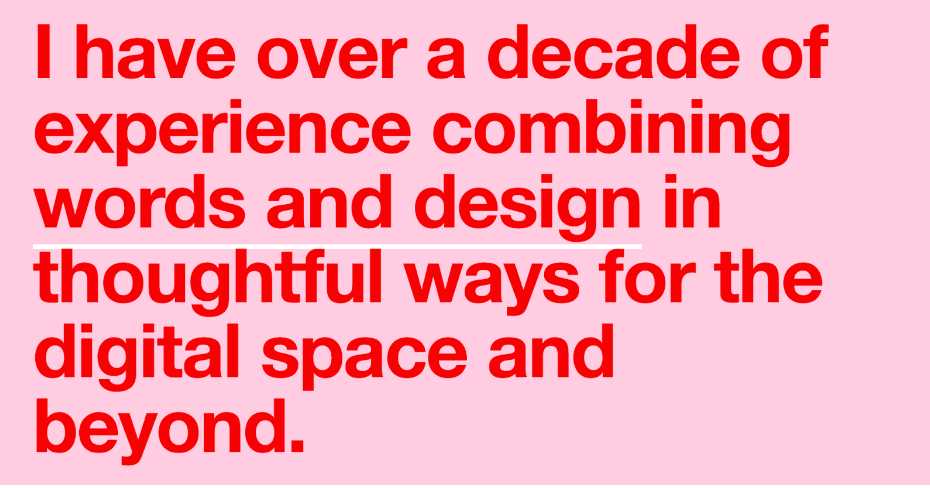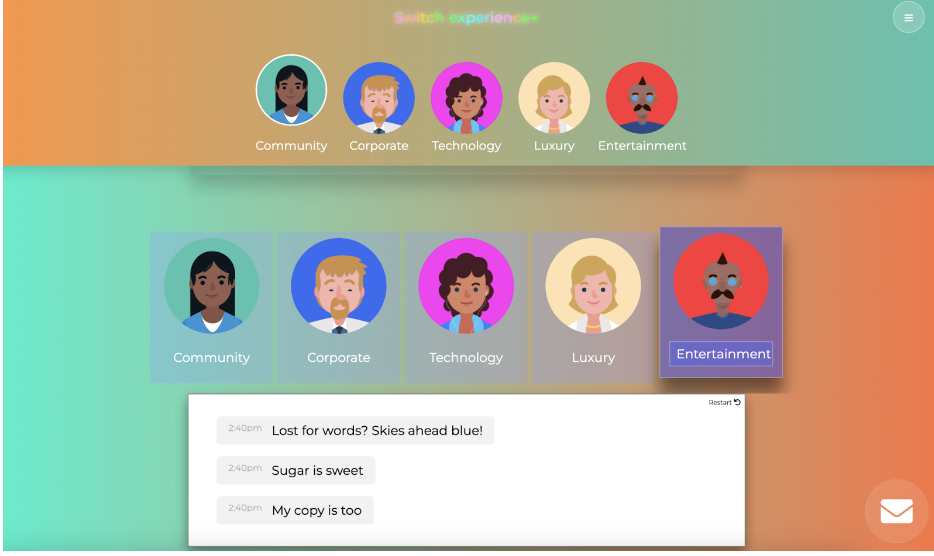UX writing or content design is an exciting and growing field, merging user-centricity with content. Wondering how to get your foot in the door of this lucrative career path? The answer is a stellar portfolio.
In this blog post, we highlight five standout UX writing portfolio examples to inspire you—and equip you with practical insights and steps to create a portfolio that will make any tech lead want you writing for their product.
Here’s what we’ll cover:
What is a UX writing portfolio, and why do you need one?
UX writing, also known as content design, is an exciting and flourishing field that focuses on crafting compelling product and microcopy to guide users across a digital interface. For career-changers and UX writing bootcamp graduates, transitioning into professional UX writing can be equal parts exhilarating and daunting. How can you prove you really know your stuff? Enter your UX writing portfolio.
A UX writing portfolio is more than just a collection of written samples. It’s a curated presentation of your skills in crafting user-centric copy that aligns with design to create seamless digital experiences.
From buttons and error messages to onboarding flows and menu labels, a UX writing portfolio showcases how you guide users through a product with the power of words.
Let’s explore a few reasons why every UX writer needs a portfolio:
- Demonstrating skill: It’s one thing to say you’re adept at UX writing, but a portfolio lets your work do the talking. This also includes adding context to your choices—by explaining why you selected specific words or phrasing, hiring managers can get a glimpse into your decision-making process and your strategic approach to UX writing.
- Bridging the experience gap: In place of years of UX writing experience under your belt, a robust portfolio is a showcase of your trained abilities and transferable skills—placing you on par with more experienced contenders. Here’s where you can tell your career-change story!
- Clarifying your niche: Every writer has preferences and areas of expertise—whether it’s mobile app microcopy or website content design. A well-curated portfolio helps you carve out your niche and showcase your strengths—which can help you land the roles you’re genuinely interested in.
What should be in a UX writing portfolio?
As you embark on your journey into UX writing, you’ll quickly realise that your portfolio is your strategic ally; opening doors and paving the way to your new career. In other words—it needs to be good. So, what are the key components that make up a UX writing portfolio?
- Introduction and background: Companies don’t hire portfolios, they hire people. Who are you? What’s your story? Especially for career changers and recent graduates, the importance of a good introduction cannot be overstated. This crucial context can provide insight into your unique perspective and the skills or experiences you bring to UX writing.
- Diverse samples: Good UX writing portfolios show a range of work. This includes microcopy, error messages, onboarding flows, and other pieces you’ve crafted to demonstrate your versatility in handling various UX writing challenges.
- Case studies: Instead of just showcasing the final product, present a few projects as case studies. Detail the problem, your approach, and the solution. Highlight iterations, feedback, and the reasons behind certain decisions. This offers a window into your problem-solving skills and process.
- Reflection and rationale: For each project, add some insight into why you chose certain words or phrasing. Was it to align with a brand’s voice? Or to simplify a complex process? Sharing your thought process shows potential employers what you bring to the team beyond your writing skills.
- Iterations: A huge part of any good portfolio is storytelling. Beyond your personal story, you should also tell the story of how your projects came to be. How did your writing evolve based on feedback? What previous iterations led you to the wording that truly landed? What user testing did you do to keep your content accessible? Don’t just show the finished product; talk them through how you got there.
- Testimonials: Positive feedback from teammates, clients, or course instructors can add credibility to your work. Don’t have any industry experience? Don’t panic! Even positive feedback from course instructors will go a long way in making your portfolio stand out.
- Soft skills: UX writing isn’t just about penning perfect copy. Collaboration, adaptability, and the ability to accept and implement feedback are equally critical. Find subtle ways to weave in these skills, i.e., through anecdotes or proof points from your past career.
- Contact information: This might seem basic, but don’t forget to ensure potential employers or clients can effortlessly contact you. Include your professional email, LinkedIn profile, or any other relevant communication channels in your portfolio.
Read next: What’s the difference between UX writing and copywriting?
5 of the best UX writing portfolio examples (and what we can learn from them)
Lauren Reichman’s UX writing portfolio
With a balance of bright colours and minimalistic design, Lauren’s UX writing portfolio seamlessly marries personality with purpose. Interestingly, Lauren chooses to let the words take centre stage, largely opting out of visual aids—which only amplifies her unwavering dedication to her craft.
Right from the start, Lauren introduces herself with a compelling opening statement that quickly communicates her value and expertise. Her cleverly placed underline also shows that she knows how to guide users’ eyes across a piece of text.
As we dive into her showcased works, it becomes clear that she’s incredibly versatile—with projects spanning style guides, UX writing, content design, and brand copywriting. While her portfolio might be more pared back, she still doesn’t skimp on the details; each project offers the perfect amount of context into her process without bogging us down with text.
Key takeaway: A well-curated UX writing portfolio can shine with authenticity and personality without it distracting from the purpose.
Diego Cagara’s UX writing portfolio
Diego’s UX writing portfolio offers an intriguing journey through his professional evolution. As a career-changer, his roots trace back to journalism—where he achieved recognition and crafted compelling copy for editorial giants like Spotlight News and Times Union.
His past career as a successful journalist isn’t just a footnote; Diego thoughtfully integrates it into his UX narrative. He’s even authored a Medium article highlighting the synergy between strong journalism and effective UX writing, which he proudly showcases alongside the rest of his work (as he should!).
Beyond just UX writing, Diego’s portfolio delves into content strategy, UX research, and copy decks. When you explore his individual projects, you see responsive designs accentuated by subtle animations that bring the content to life. Diego’s transparency really makes the content feel authentic; he offers thorough insights into his methodologies and reasoning, illuminating his holistic approach.
Key takeaway: Your transferable skills from past experiences are a strength, not a weakness. Don’t be afraid to show them off in your UX writing portfolio!
Slater Katz’s UX writing portfolio
Having built an influential presence in the UX writing community, Slater Katz has carved out a distinct niche as a guiding light for budding freelancers. Her UX writing portfolio mirrors this expertise, offering a masterclass in storytelling.
Central to Slater’s portfolio is her strong personal brand. Her witty ‘about me’ tagline emphasises her ability to blend creativity with skill. Her portfolio’s cohesive interface, which seamlessly balances text and design, showcases her adeptness at creating holistic digital experiences. Each project in her work section is accompanied by a unique graphic, reflecting her attention to detail (a quality every client and hiring partner wants in a UX writer!).
Beyond how well-crafted her project pages are, we’re seeing a few things in Slater’s portfolio that truly make it stand out: Her motto, a dedicated advice section with insightful blog posts, and a unique ‘learn UX writing’ segment connecting to her community platform. These unconventional additions tell us one thing: For Slater, UX writing extends well beyond the confines of a traditional job—it’s a vested passion.
Key takeaway: You don’t have to be an influencer to build a personal brand as a UX writer. It’s all about crafting a cohesive story that visitors won’t forget.
Nicole Alexandra Michaelis’ UX writing portfolio
When you land on Nicole Alexandra Michaelis’s portfolio, you’re immediately immersed in the world of a seasoned UX writer and content designer. Having crafted words for industry giants like Spotify, SAS, and Wolt, her credentials are undeniable.
Beyond her portfolio, Nicole’s influence in the UX realm is palpable; she’s a respected educator at Berghs School of Communication and Hyper Island, and lends her voice to the much-followed Content Rookie Podcast.
Nicole’s portfolio offers more than just a glance at her achievements. It presents a curated selection of her favourite projects, giving us a sneak peek into what drives her forward. Nicole’s distinct approach to branding revolves around three pillars: culture, content, and creativity. It’s evident from her homepage, which exudes playfulness, yet underscores her professional prowess. Adding a fresh twist, she sidesteps traditional portfolio headings, opting for engaging prompts like ‘Why am I doing this?’ and ‘This is why I’m good at it’. This innovative touch not only offers a peek into her unique personality but also underlines her mastery of the art of communication.
Key takeaway: Combining professional experience with a personal touch can create an engaging narrative, setting a benchmark for impactful and authentic UX storytelling.
Nathan Mudaliar’s UX writing portfolio
Stepping into Nathan Mudaliar’s UX writing portfolio feels like entering into an immersive video game experience. The futuristic design, complemented by lively animations, immediately showcases Nathan’s advanced grasp of cutting-edge design.
A standout feature is the website’s innovative dropdown, which lets visitors ‘switch experiences’ across five unique themes, altering the site’s aesthetic and colour palette. The option to choose avatars that modulate chatbot voice and tone is a testament to Nathan’s commitment to creating tailored digital journeys.
The portfolio’s structure is well-organised and deliberate. Nathan segments his expertise, providing dedicated spaces for his prowess in digital copywriting, UX writing, and blog writing—letting each skill breathe.
Key takeaway: Interactivity and customisation go a long way in a UX writing portfolio, offering a captivating example of how to engage and adapt voice and tone to individual user preferences.
How to create a UX writing portfolio
Building a standout UX writing portfolio takes more than a list of links to projects; it’s an encapsulation of your approach, values, and growth as a UX writer.
Here are some tips and best practices to keep in mind as you craft your UX writing portfolio:
Stay authentic
Your UX writing portfolio should be a reflection of who you are. Adopting the latest design trends or copying someone else’s style is tempting, but remember—authenticity always stands out. Try to avoid over-stylising or adding unnecessary frills—your work, your words, and your commitment to crafting a great user experience should be at the forefront.
Quality over quantity
A well-curated collection of your best work can speak volumes. While it’s natural to want to showcase everything you’ve ever done, it’s essential to prioritise pieces that demonstrate your depth, versatility, and problem-solving chops. Each sample should offer value, whether it’s showing a unique challenge you tackled or a distinct voice you crafted.
Seek feedback
You wouldn’t write product copy without testing it with users, so don’t create a portfolio without getting feedback! Before you deem your UX writing portfolio ready for the world, get a fresh set of eyes on it. Whether it’s peers, mentors, or friends, varied perspectives can unveil areas of improvement, from minor typos to suggestions on layout. Feedback can transform your portfolio from good to exceptional, ensuring that when potential employers or clients view it, it’s the best possible version of your work.
Highlight collaborations
UX writing is rarely a solo endeavour. It often involves synergistic collaborations with designers, developers, product managers, and other stakeholders. Emphasise these collaborative efforts in your portfolio. Narratives highlighting teamwork underscore your ability to be a valuable player in multidisciplinary teams, reinforcing that you’d be a great addition to any UX team.
Keep your UX writing portfolio updated
The UX world moves quickly, and user needs are always evolving. Keeping your portfolio updated is a sign of your continuous growth and adaptability. As you take on new projects, face unique challenges, or acquire fresh testimonials, be sure to incorporate them. To get you started, check out our blog post on the future of UX writing and content design.
Excited to kickstart your journey into the dynamic world of UX writing? With The UX Design Institute’s new Content Design (UX Writing) Course, you’ll build a rewarding career in content design and UX writing with a globally recognised, industry-approved qualification (and a portfolio full of real-world projects).










